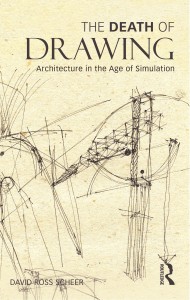 After what seems like an eternity, The Death of Drawing: Architecture in the Age of Simulation has been published. It will shortly available for purchase on Amazon (July 27) and through Routledge (July 25) as well as in many bookstores. Now that the book is public, it takes on a life of its own. This prospect is both exciting and anxiety-provoking. It’s not that I’m worried about people disagreeing with me. I expect and welcome that. The question that keeps me awake at night is whether they will understand what I tried to say.
After what seems like an eternity, The Death of Drawing: Architecture in the Age of Simulation has been published. It will shortly available for purchase on Amazon (July 27) and through Routledge (July 25) as well as in many bookstores. Now that the book is public, it takes on a life of its own. This prospect is both exciting and anxiety-provoking. It’s not that I’m worried about people disagreeing with me. I expect and welcome that. The question that keeps me awake at night is whether they will understand what I tried to say.
The book’s subject is fraught. Discussions of the effects of building information modeling and computational design on architecture are often polarizing. Older architects tend to view these technologies as either new ways of doing the same work or as unwarranted intrusions into a process they understood. Younger ones tend to be advocates of the new technologies without considering their effects on the work. Add to this the perennial tendency of every new generation of architects to consider themselves young lions and every older generation to resist change, and you have a perfect storm of misunderstandings. I hope the book will help both groups gain insight into what is going on, but I realize that’s a steep hill to climb.
I believe that architecture is undergoing profound change that architects need to understand lest we become its passive victims. Neither older nor younger architects can easily understand the changes taking place. Older ones have trouble grasping the new technologies while younger ones have little understanding of what is being replaced by them.
One of my greatest fears is that The Death of Drawing will be understood as a plea for a return to drawing. Nothing could be further from my intention. In the book I explain that the rise of BIM and computational design is grounded in modern building economics and certain pervasive cultural developments. These technologies are not going away- they can help solve real problems for building owners and users. The book’s central thesis is that these technologies promote certain tendencies that run counter to architecture’s ability to comprehend and assert essential but unquantifiable values. I try to show how drawing enabled us to do this. What I’m advocating is not a return to drawing, but a search for ways to use the new technologies to continue to assert such values. I believe that a thorough understanding of the historical role of drawing will help us do that.
Another of the book’s central arguments concerns the the effects of the materiality of drawing on how we understand architecture. Drawings are made things, physical artifacts that are as much about the materials that compose them as they are about the ideas they represent. The intimate experience of materials provided by drawing carries over into building. Despite the obvious differences between drawing and building materials, the experience of making, of the productive encounter between an idea and the physical qualities of the media used to express it, is common to building and design through drawing. Going forward, this is a challenge for interface design which is already being studied by many people.
It may very well turn out that the best way to do all this is to preserve a place for drawing in our new, technology-enabled design processes. This is what I do in my own practice and there are many other architects who do this as well. But incorporating drawing in any fashion requires an architect to have experienced design through drawing. When I see digital techniques being used by architecture students with little or no experience of drawing, I lose hope that this will be possible.
Anyway, buy the book, read it and see what you make of it. Please post your thoughts on this blog. I look forward to a lively discussion.
David Ross Scheer